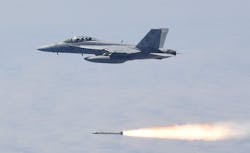Navy picks Northrop to build lot 3 of AGM-88G AARGM-ER radar-killing missile with GPS and inertial guidance
PATUXENT RIVER NAS, Md. – U.S. Navy aerial warfare experts are ordering a new batch of the AGM-88G Advanced Anti-Radiation Guided Missile-Extended Range (AARGM-ER) to equip U.S. military combat aircraft.
Officials of the Naval Air Systems Command at Patuxent River Naval Air Station, Md., announced a $235.7 million contract last week to the Northrop Grumman Corp. Mission Systems segment in Northridge, Calif., for 118 low-rate initial production lot 3 AGM-88G AARGM missiles.
Of these 118 missiles, 84 AGM-88G AARGM-ERs are for the Navy, and 34 are for the U.S. Air Force; six are AGM-88G AARGM-ER captive air training missiles; eight are telemetry/flight termination system kits for the Navy; and 10 are dummy air training missiles for the Air Force. The contract includes initial spares, special tooling and test equipment kits, and related supplies and support.
AARGM is the newest version of the AGM-88 missile, and is compatible with U.S. and allied strike aircraft, including the F/A-18 fighter bomber, EA-18G electronic warfare jet, F-16, and F-35.
The AARGM features an advanced digital anti-radiation homing sensor, millimeter wave radar terminal seeker, global positioning system (GPS) guidance, inertial navigation system guidance, net-centric connectivity, and weapon-impact-assessment (WIA) transmit.
The AGM-88G enables the U.S. Navy, U.S. Marine Corps, and allied combat jets to attack and destroy enemy air-defense radar systems and time-critical mobile targets.
The missile offers improved capabilities over the HARM systems it replaces, including advanced signal processing, improved frequency coverage, detection range, and field of view; time-critical, standoff strike; missile-impact zone control to prevent collateral damage; counter-emitter shutdown through active millimeter wave radar terminal guidance; and bomb damage assessment.
The AGM-88G AARGM-ER uses the guidance system and warhead of the AGM-88E, and uses a solid integrated rocket-ramjet engine to double AGM-88E's range. It incorporates a redesigned control section and 11.5-inch diameter rocket motor for twice the range and internal carriage on the Lockheed Martin F-35A and F-35C Lightning II Joint Strike Fighter.
The AGM-88G, integrates the AGM-88E's warhead and guidance systems in a new airframe that replaces the mid-body wings with aerodynamic strakes along the sides with control surfaces relocated to low-drag tail surfaces and a more powerful propulsion system for greater speed and double the range of its predecessor. The AGM-88G weighs 1,030 pounds and is 13.3 feet long.
The AARGM-ER features new software and enhanced capabilities to counter radar shutdown and passive radar using an additional active millimeter wave seeker. Previous versions of the missile could be spoofed by turning off radar before the weapon could lock on to their signals.
On this contract Northrop Grumman will do the work in Northridge and Ridgecrest, Calif.; and in Rocket Center, W.Va., and should be finished by February 2027. For more information contact Northrop Grumman Mission Systems online at www.northropgrumman.com/who-we-are/business-sectors/mission-systems, or Naval Air Systems Command at www.navair.navy.mil.
